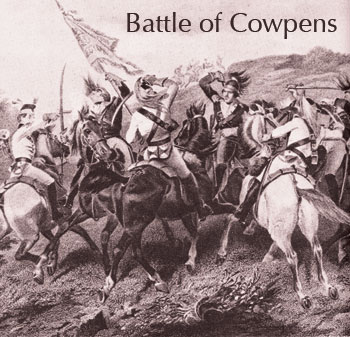
It usually pastures cattle on their way to market. But on a frigid January morning in 1781, this "open woods" near the Carolinas’ border fields a ragtag band of Patriots. These friends of freedom are about to defy some of the world’s most professional soldiers. Defeat seems almost certain for them. In fact, some of them had ignominiously fled the field five months before. But not this time. Thanks to ingenuity, pluck, and the blessing of Providence, they will win one of the most heartening battles of the American Revolution. Some are veterans; many are inexperienced militia. Led by a brilliant but untrained commander, they will thrash skilled Redcoats fighting under a previously unbeaten officer. No wonder the improbably named Cowpens encourages modern patriots.
War had raged up and down the Atlantic seaboard for almost six weary years by now. At first, the British government concentrated on quashing the rebellion in New England — specifically Boston. But Patriots there won a surprising victory, one so overwhelming that the Redcoats boarded ship and sailed away in March 1776.
Meanwhile, King George III and his cabinet eyed the South with plans for a beachhead at Charles Town, South Carolina. From there, troops would spread through the countryside to secure it for the Crown. But the Patriots won another surprising victory that June when they bombarded incoming British transports so furiously soldiers could not disembark.
Repulsed from Boston and Charles Town, His Majesty’s forces converged on the mid-Atlantic colonies instead. The Patriots’ successes skidded into reverse as the British Army once again proved itself the world’s most efficient enforcer. The British lost an occasional battle during the next couple of campaigns, but the Patriots paid dearly for their victories as they shivered and starved at Valley Forge and Morristown.
Tide Turns Against Independence
The war was slowly, ponderously grinding away, boring to death those it hadn’t yet killed, when the British decided to try the South again. George Germain, the king’s secretary of state for the American department, explained why: "Should the success we may reasonably hope for attend these enterprises, it might not be too much to expect that all America … south of the Susquehanna would return to their allegiance and … the northern provinces might be left to their own feelings and distress to bring them back to their duty." This time, the beachhead succeeded, and troops landed in Savannah, Georgia on December 29, 1778.
More conquests followed, including Augusta and then, after a second attempt, proud Charles Town. Capping these was the hopelessly lopsided rout at Camden, South Carolina, in August 1780. Three thousand Americans vied with 2,000 of the enemy, yet one Patriot was killed, captured, or wounded for every soldier fighting for the king. Multiplying the mortification was the furious flight of the American commander, 53-year-old Horatio "Granny" Gates. He galloped from the debacle so fast that he covered "one hundred and eighty miles in three days and a half," as Alexander Hamilton acidly marveled. Not only did he outrun his "whole army," his speed did "admirable credit to the activity of a man at his time of life." Gates’ few surviving soldiers eventually caught up with him, but it took them three days.
On Camden’s heels came electrifying news that shocked both America and England. One of the Patriots’ most talented generals had switched sides, trying to take one of the Patriots’ most valuable forts with him. Benedict Arnold’s defection would surely boost the Redcoats to victory.
Things seemed black as a tyrant’s heart as the year of 1780 limped toward its end. Only a few sparks flickered here and there to brighten the gloom. Nine hundred Patriot militiamen at King’s Mountain killed or captured almost a thousand Loyalists marching to reinforce British General Charles Cornwallis. And Nathanael Greene replaced "Granny" Gates as the American commander in the South.
Greene was one of the Continental Army’s self-taught geniuses while Gates, formerly a British officer, relied on traditional tactics rather than innate brilliance. Neither Gates nor any officer schooled in military strategy would have divided the few thousand troops mustering that December morning when Greene assumed command, especially with Cornwallis boasting more than double his numbers. Yet the adaptable Greene realized that he was "obliged to put everything to the hazard … to make detachments that nothing but absolute necessity could authorize." So he split his little army to "[make] the most of my inferior force" while "compel[ling] my adversary to divide his, and hold him in doubt as to his line of conduct," i.e., whether to chase Greene or his detachment. Greene assigned that detachment of 600 men to another of the Continental Army’s untrained geniuses, Daniel Morgan.
Lashed Into a Fury
Born in New Jersey in 1736, Dan Morgan left home early and wended his way to Virginia’s backcountry. He grew into a giant of a frontiersman with the breed’s legendary stamina: he once survived an Indian ambush that sent a bullet through his neck and out his cheek, taking some teeth with it. He cleared land for a while, supervised a sawmill, and hauled supplies over the mountains to settlers — and for the British Army during the French and Indian War. But the deference and obedience the British expected from him didn’t mix with Morgan’s independence. Accounts vary as to what provoked him, but he wound up punching a British officer. For this he was sentenced to 500 lashes, a common punishment that often crippled or killed the victim. Morgan not only survived, he later claimed that the Redcoats still owed him one blow — implying that he lost neither consciousness nor the rationality to count.
Morgan avenged himself by fighting furiously and ingeniously against his torturers throughout the Revolution. He recruited a company of riflemen as the war began and marched them 600 miles in three weeks from Virginia to the rudimentary Continental Army assembling around Boston in 1775. That fall, he and his riflemen headed north with Benedict Arnold on an ill-fated expedition to liberate Canada. Morgan’s stunning stamina helped him endure the starvation and exposure that killed some of the column while driving almost half of it to turn back in mutiny. He led the assault on walled Quebec after Arnold fell with a bullet in his leg, but his valor was in vain: he and all his men were captured. After his release, he rejoined the Continentals. He fought with Arnold again — and Gates as well — at Saratoga in the fall of 1777. There he famously "collect[ed] his dispersed troops" with a "turkey call" rather than the fife and drums that usually signaled maneuvers during battle.
Like Arnold, Morgan was a proud man of action who disdained to curry congressional favor. Congress duly forgot to promote both officers. Morgan retreated to Virginia, sitting out the war until the disaster at Camden brought him roaring out of retirement; he’d witnessed Gates’ timidity at Saratoga and knew the cause was lost were "Granny" left on his own. Congress belatedly commissioned Morgan a brigadier general. Whatever pay went with that promotion didn’t reach Morgan in time: he took a horse to sell so he could pay his expenses as he hurried to join Gates.
The 1,700 troops Gates ceded to Greene included the remnants of the force that fled Camden. Its poverty was sobering, especially as it must defend the South from Cornwallis’ 4,000. "We are living upon charity," Greene wrote after fruitlessly begging supplies from politicians in Maryland and Virginia, "and subsist by daily collections. Indian meal and beef is our common diet, and not a drop of spirits have we had with us since I came to the army. An army naked and subsisted in this manner, and not more than one-third equal to the enemy in numbers [after Greene divided his forces], will make but a poor fight."
Sharing those meager rations with Camden’s veterans was the militia. And as any regular army man would testify, militia could be worse than no troops at all. General George Washington dismissed these volunteers as "a broken reed" that would betray any officer foolish enough to lean on them. He also lamented the militia’s tendency to consume rations while lounging about camp and avoiding battle.
Militiamen are defensive rather than offensive, and they were crucial to colonies hoping to survive an ocean away from the British Army on land already claimed by Indian tribes. That’s why colonial legislatures passed laws requiring able-bodied men from 16 to 64 years old to report for "muster days" with their weapons. These sessions were supposed to teach the "art" of war; more often, they taught the arts of drinking and swapping stories. But every household was theoretically able to defend itself when the Revolution began.
As the war progressed, Continental officers came to despise these amateurs. Sometimes that was due to the militia’s performance under fire — though blaming farmers and shopkeepers because they can’t execute maneuvers and withstand artillery with the aplomb of trained troops is like blaming a loaf of bread because it can’t lock and load. Yet armed citizens defending their families and homes from direct threats often fight more ferociously than hired soldiers; commanders like Benedict Arnold and his friend Daniel Morgan understood that and prized the militia for it. Their genius lay in capitalizing on this strength, as Morgan would at Cowpens.
Learning of the rebels’ unorthodox division, General Cornwallis responded with his own, just as Greene had foreseen. Cornwallis sent 750 troops and a couple of cannon after Morgan. In command he put the ruthless, 27-year-old Col. Banastre Tarleton.
"Boys, Get Up! Benny Is Coming!"
Tarleton was Morgan’s physical opposite. He was a dandy, small and slight, whose portrait the chic Sir Joshua Reynolds would paint in 1782. But like Morgan, Tarleton had fought from the war’s earliest days and racked up a string of conquests. He captured the eccentric American General Charles Lee in December 1776, helped take Charles Town in 1780, and a fortnight after that battle defeated — some said butchered — 350 Virginians at the Battle of the Waxhaws. None of this kept him too busy to plunder and terrorize civilians. By the time he collided with Morgan at Cowpens, Tarleton seemed invulnerable. Even his commanding officer lavished praise on him: "I wish," Cornwallis wrote him, "you would get three Legions, and divide yourself in three parts. We can do no good without you" — as if this vicious bully ever did good.
The chase was on. Morgan marched his detachment 58 miles in a cold rain to the Pacolet River, attracting more militia along the way. South Carolina’s abundant waters would slow his pursuers; still, Tarleton’s better-fed and mounted men would eventually catch up. "Colonel Tarleton is said to be on his way to pay you a visit," Greene wrote Morgan on January 13, 1781. "I doubt not but he will have a decent reception and proper dismission."
In addition to rivers, the country was rife with marshes. They sheltered Patriot irregulars like Francis "Swamp Fox" Marion and Thomas Sumter as their handfuls of guerillas battled the superior British numbers. Many commanders in Morgan’s situation would have melted into those bogs and chastised the enemy with raids, not a battle. Instead, Morgan decided to make a stand. He chose a field known as Hannah’s Cow Pens.
Just as no orthodox commander would have divided his forces, so he would never have selected such a battleground. Rivers swollen with winter storms almost completely enclosed it; if things went badly, Morgan’s troops could not escape. But the general saw his militia realistically. They were used to slaughtering hogs, not other men, and if he offered them the chance to run, they would. "As to retreat," he explained, "it was the very thing I wished to cut off all hope of. I would have thanked Tarleton had he surrounded me with his cavalry. It would have been better than placing my own men in the rear to shoot down those who broke from the ranks." On the other hand, if he gave the militia a chance to shine, it would: "When men are forced to fight they sell their lives dearly."
Morgan’s strategy was as unconventional as his battlefield — but it transformed the militia’s weakness into strength. The general laid out three lines. The hindermost at the top of a ridge consisted of his regular Continentals. Two lines stood between those soldiers and the British: the middle one was militia, and in front of it, comprising the first line, stood 150 riflemen. The militia and riflemen received the same orders, which were to fire three shots (some participants remembered it as two shots) at the advancing British and then do what militia does best: bolt for the rear. If necessary, they could rejoin the fighting later.
Major Thomas Young of Morgan’s cavalry recalled how the huge frontiersman "went among the volunteers" the night before the battle, "helped them with their swords, joked with them about their sweethearts, told them to keep in good spirits, and the day would be ours. And long after I laid down, he was going among the soldiers, encouraging them, and telling them, that the old wagoner would crack his whip over Ban [Tarleton] in the morning as sure as they live. ‘Just hold up your heads, boys, three fires,’ he would say, ‘and you are free, and then when you return to your homes, how the old folks will bless you, and the girls kiss you for your gallant conduct!’ I don’t believe he slept a wink that night."
January 17 dawned "bitterly cold" in Young’s estimation. Morgan’s pickets reported that Tarleton was on his way, prompting the giant to ride around camp, yelling, "Boys, get up! Benny is coming!"
Morgan’s Masterpiece
Tarleton’s advent brought exactly the action — and reaction — that Morgan had planned. Young remembered that "the militia fired first. It was for a time, pop — pop — pop, and then a whole volley; but when the regulars fired, it seemed like one sheet of flame from right to left. Oh! it was beautiful!"
As if his strategy weren’t clever enough, Morgan also turned his adversary’s strength against him. Tarleton was a ferocious warrior who waded into melees headfirst. Indeed, when he learned that Morgan was awaiting him at Cowpens, Tarleton gloated in the third person that the ground was "certainly as good a place for action as Lieutenant Colonel Tarleton could desire. America does not produce any more suitable to the nature of the troops under his command."
Morgan bet that such an eager beaver wouldn’t stop to analyze the action before advancing; rather, he would assume that when the militia ran for the rear, it was fleeing as usual; that the raging river would trap it as he believed it had the entire army; and that he could pick off rebels at his leisure. Sure enough, Tarleton rushed into battle before his lines had enough time to form, as though Morgan had supplied him with a script – and ran headlong into the Continental regulars. "Our advance … fell back," a British officer recalled, "and communicated a panic to others … a total rout ensued. Two hundred and fifty horse … fled though the woods with the utmost precipitation, bearing down such officers as opposed their flight." Major Young exulted that the Redcoats "did the prettiest sort of running!"
Tarleton finally followed his men, with Morgan in hot pursuit for 24 miles. "But," Morgan explained, "owing to our having taken a wrong trail at first, we never could overtake him." Tarleton’s humiliation was complete when he eventually returned to camp and discovered Loyalist supporters looting it. Talk about a bad day!
The fighting lasted only an hour, from around 8 a.m. until 9. And midway through, some of the Continental line mistakenly wheeled for a retreat, thinking Morgan had ordered that until he himself rallied them. Yet Cowpens was one of the Patriots’ most stellar victories, proportionally speaking, as devastating to the British as Bunker’s Hill or Trenton. Morgan’s men destroyed almost 90 percent of Tarleton’s detachment — 100 dead, 229 wounded, and 600 captured — while losing only 12 killed and 60 wounded themselves. The triumph also tarnished Tarleton’s luster.
The Continentals’ coup at Cowpens reverberated through the country. At Ramsour’s Mill, where the British Army camped a week after the battle, a shaken Cornwallis ordered his 3,000 troops to burn anything they couldn’t conveniently carry, the better to fly after Morgan. And when the Patriots and Redcoats clashed at Guilford Court House on March 15, Greene recycled Morgan’s strategy. Technically, Greene lost the battle, but he exacted such heavy casualties that Charles James Fox cautioned Parliament, "Another such victory would destroy the British army."
Greene repeated the ploy at Eutaw Springs on September 8, 1781; the British again defeated him. Yet, as Fox had warned, Greene somehow regained South Carolina despite his losses on the battlefield. The enemy held only Charles Town when they surrendered at Yorktown six weeks later.
After Morgan’s victory, a praying Patriot thanked the "Good Lord, our God that art in Heaven" for the "ever-memorable and glorious battle of the Coopens, where we made the proud Gineral Tarleton run doon the road helter-skelter." Amen! And sic semper tyrannis!
Becky Akers is an expert on the American Revolution.




